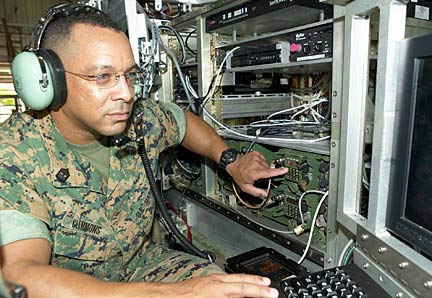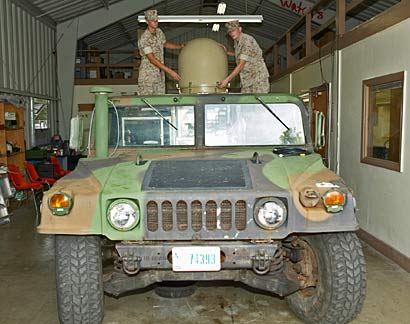
|
Isle firms aid
Marine mission
A multimillion-dollar plan
is to build a mobile system for
battlefield communications
With the help of a local research and development company, Marines on the front lines may soon be able to communicate with real-time video, voice and data transmissions.
David Ushio, who heads Pacific Technologies, said "for years the Marines -- who generally are the guys who are the first to go in -- have pushed for some sort of over-the-horizon communications system."
Ushio, 59, said the radio communications now used by the Marines depend on "line-of-sight," which is hampered by mountains, buildings or other physical terrain features that may block the transmission.
The Pentagon has approved $9 million for his two-year-old project to help develop what he describes as "an on-the-move" portable unit small enough to fit in a Humvee that would allow Marines to communicate with their command headquarters via satellite oceans away from the battlefield.
Ushio is hoping to receive another $20 million from the Pentagon to begin testing what is being called the "mobile modular command center," or M2C2.
"Many of the components of the M2C2 will be built and assembled locally," Ushio added.

Pfc. Kristropher Bedley, left, and Sgt. Rusty Pickett, both radio operators at Kaneohe Bay, adjust the antenna dome on a prototype communications Humvee.
"It can be a shot in the arm for Hawaii's economy since all of the components will be assembled in Hawaii," Ushio said.
Eight island-based companies are involved in this project and Ushio estimates that as many as 50 new jobs will be created.
Although the cost or production has not been established, Ushio said current estimates range at just over a $1 million for each communications vehicle. Two prototypes were built in Hawaii and are now being tested at the Kaneohe Marine Corps facility. The prototypes will be taken to Southern California next month for another series of tests during Marine Corps exercises.
Ushio said the Marine Corps not only supplied the two Humvees used in the development of the communications system, but also Kaneohe Marines who have fought in Iraq and Afghanistan.
"We used to meet with them once a month," Ushio said, "until they deployed to Iraq and Afghanistan and then meetings were held quarterly."
Although the Army has fielded reliable satellite communications systems, Ushio said, "they are not mobile and need time to set up and tear down. The Marines must move quickly, and the first hours and days of an invasion are often most dangerous. During the early hours, there are gaps to the current communications system that can result in Marines not being able to communicate with each other or their commanders."
He said, "The entire communications package is light enough to be lifted by helicopter to a target zone, or dropped by parachute to ground zero."
Ushio credits Sen. Daniel Inouye who met with the leaders of the Marine Corps at Camp Smith to determine what their priority needs were.
Working with the Office of Naval Research, Ushio said, Inouye got the Senate Appropriations Committee to approve the demonstration project.
For his part, Inouye told the Honolulu Star-Bulletin: "Marines are our first responders. They operate under dangerous conditions in difficult terrain. The Mobile Modular Communication Command Center provides them with an easily transported, high-tech communications system. This system, by allowing them to be in communication at all times under all circumstances, will go a long way to minimizing the dangers they face in the field."
Ushio said this project has been successful because both the Marines in the field and its top Marine leaders in the Pacific, like Lt. Gen. Wallace Gregson who retired last month as head of the Marine Forces Pacific, endorsed M2C2.
Gregson's predecessor, Lt. Gen. Earl Hailson, also noted that the project "addresses a gap in data communications for controlling joint fires and maintaining situational awareness during the first hours and days of an assault. Its capabilities must be aggressively pursued to enable our kick-down-the-door mission."
Master Gunnery Sgt. Mark Clemmons, a 27-year veteran who fought in the 1991 Gulf War and participated in the Dec. 26 Pacific tsunami relief efforts, believes: "Without a doubt this will save lives. When it comes to communication, speed is important. This will give you eyes and ears in much faster time."
The three island companies involved in developing the system's antennas are now attempting to reduce the size of a 5-foot dome antenna, whose configuration on the top of the Humvee clearly marks it as a special target.
Ushio said the Secret Service has developed an antenna system that is unnoticeable.
The communications package can also support humanitarian and disaster relief. "Personnel can communicate with M2C2 by radio, cell phone, and personal computing devices such as PDAs, pocket PCs and laptop computers. They can also send and receive data such as maps, weather reports and early warning assessments. During humanitarian missions, rescue workers can call for help, assistance, medical aid and provide damage reports," Ushio said.
He said such communications capabilities were vital following the Dec. 26 Indonesian Pacific tsunamis or even here locally when Hurricane Iniki in 1992 wiped out Kauai's power and communications network.
E-mail to City Desk
[News] [Business] [Features] [Sports] [Editorial] [Do It Electric!]
[Classified Ads] [Search] [Subscribe] [Info] [Letter to Editor]
[Feedback]
